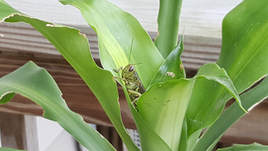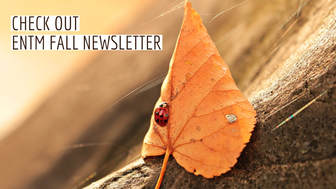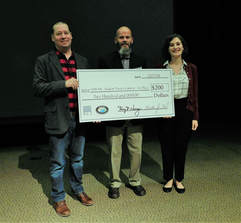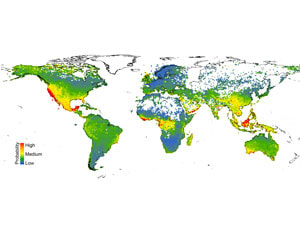|
Written by: Darsy Smith & Lindsay Barranco
Destruction by crop insects requires strategies to combat pests below ground and above ground. Dr. Hiltpold’s novel approach uses nature to do this work.  Photo credit: Sergey Photo credit: Sergey Written by: Dylan Kutz & Serhat Solmaz Our ecosystems are under siege by plants hailing from exotic realms. Can one of nature’s most ubiquitous insects be the key to saving protecting our native locales from invasion?  Check out our Fall 2018 Entomology Department Newsletter to see what we've been up to! Content includes news on publications, awards, defenses and much more. Is there something you'd like to see in the Spring 2019 edition? Let us know by sending an e-mail to [email protected]. Enjoy!  Congratulations, Julianna Greenberg (Biological Sciences Undergrad, Palmer Lab) for winning first place in the Student Poster Competition at the Maryland Water Monitoring Council’s Annual Meeting. Julianna’s winning poster, " Evaluating the effects of system maturation on pollutant loads from stream-wetland complexes”, is on display in the hallway outside of room 4129. Abstract: Throughout the world many streams and rivers are highly degraded and scientists are working to understand when and why certain restoration efforts result in improvements and others don’t. This study focused on small urban streams in the Chesapeake Bay watershed that were slated for restoration in order to reduce the movement of excess nutrients and sediments toward Bay Waters. Church and Cypress creeks were degraded urban streams located in Anne Arundel County. These were converted to stream-wetland complexes (SWCs) that include engineered wetlands and step-pool conveyances extending to the estuarine interface. Monitoring occurred throughout the pre- and post-construction phases to estimate the changes in catchment loads of nitrogen (N), phosphorous (P), and total suspended solids (TSS) from the outflow of the restored stream reaches. Results indicate that moderate reductions in N loads and increases in TSS and P occurred since SWC implementation in Church Creek. The study authors concluded that the increases in TSS and P were due to extensive and more recent headwater restoration activities. By contrast, Cypress Creek had no recent disturbances in its headwaters and results indicate that water quality (e.g., TSS and P) has improved with system maturation. This improvement implies that shorter-term restoration studies that do not capture the maturation process may underestimate the true long-term performance of SWCs for some constituents.  Image credit: Anahi Espindola & Tara Pelletier Image credit: Anahi Espindola & Tara Pelletier Congratulations to Entomology's Anahí Espíndola, co-author of a new research paper, “Predicting plant conservation priorities on a global scale,” published in the Proceedings of the National Academy of Sciences. Anahi co-developed a machine learning algorithm that predicts which plant species may be eligible for the IUCN Red List of Threatened Species. Researchers hope this algorithm will help prioritize conservation efforts. Read the CMNS press release here>> Other notable media mentions include WIRED & Smithsonian. New and on-going research in the Entomology Department is supported by a variety of external funding sources, including federal agencies like USDA, NSF, and NIH; Maryland and other State agencies like the MD Department of Agriculture, the MD State Highway Association, and the Minnesota Department of Agriculture; and other sources like the Almond Board of California, the National Honey Board, and the North American Bramble Growers Research Foundation. For the past 5 fiscal years, Entomology has received over $4,000,000 in support from such sources as estimated by grant expenditures.
Of the 44 currently active research awards in Entomology, 16 were new in calendar year 2018.For more information on these awards choose "Read More" below. The Entomology Department at UMD is committed to encouraging people of all ages and backgrounds to engage in science. Sending students and faculty to meetings like SACNAS & ABRCMS is just one way the department is attempting to meet those commitments.
SACNAS Annual Meeting in San Antonio, TX- In October, Anthony Nearman (Ph.D. Student vanEngelsdorp Lab) represented ENTM at a recruiting booth hosted by the UMD Graduate School. SACNAS is an inclusive organization dedicated to fostering the success of Chicano/Hispanic and Native American scientists, from college students to professionals, in attaining advanced degrees, careers, and positions of leadership in STEM. ABRCMS Annual Conference in Indianapolis, IN- In November, Marcia Shofner (Senior Lecturer) attended represented ENTM at a recruiting booth hosted by the UMD Graduate School. The Annual Biomedical Research Conference for Minority Students (ABRCMS) is one of the largest conferences for underrepresented minorities in science, technology, engineering, and mathematics. Students attend this conference to present their research, enhance professional development skills, explore graduate schools, and network. |
Categories
All
Archives
June 2024
|
Department of Entomology
University of Maryland
4112 Plant Sciences Building
College Park, MD 20742-4454
USA
Telephone: 301.405.3911
Fax: 301.314.9290
University of Maryland
4112 Plant Sciences Building
College Park, MD 20742-4454
USA
Telephone: 301.405.3911
Fax: 301.314.9290

 RSS Feed
RSS Feed




